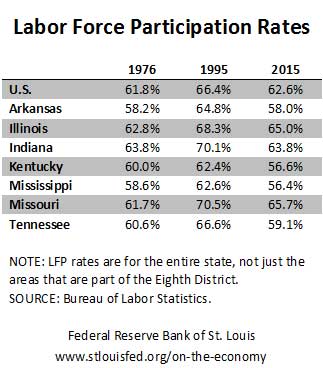Dissecting the Falling Labor Force Participation Rate
Questions about the jobless recovery following the Great Recession have spurred economists to scrutinize the nation’s rate of labor force participation (LFP).
The LFP rate measures the share of the population that actively participates in the labor market, or the total number of people employed and unemployed as a share of the working-age population.
Some economists worry that the falling LFP rate means discouraged workers are leaving the labor force. However, a recent article in The Regional Economist points to demographic change as a factor behind this decline.
Economist Paulina Restrepo-Echavarria and Senior Research Associate Maria A. Arias outlined two general views for this decline, as discussed by St. Louis Fed President James Bullard:1
- The “bad omen” view, which says that the declines in the LFP rate are due to people leaving the labor force because of the poor state of the economy
- The “demographics” view, which states that the changes in the rate are a reflection of changes in the demographics of the labor force
Trends in LFP Rates
The national LFP rate hovered between 58 and 60 percent until the early 1970s, before increasing at a relatively rapid pace. It surpassed 66 percent by the end of the 1980s, then continued increasing until peaking at 67.3 percent in 2000. The rate remained fairly stable (declining only slightly) until 2009, when the pace of decline accelerated.
A similar pattern also can be seen in the seven states that are part of the Eighth Federal Reserve District,2 with LFP rates peaking sometime between 1995 and 2000.
To examine the trends in LFP rates, Restrepo-Echavarria and Arias analyzed the gender, age and education characteristics of the working-age population.

Female Participation Up, Male Participation Down
Between 1985 and 2015, women increased their share of the workforce by 2 percentage points nationwide. For District states, the increases ranged from 1 percentage point in Missouri and Tennessee to 5 percentage points in Indiana and Kentucky.
During that same period, the share of males not participating in the labor force rose 7 percentage points nationwide. The share also increased in District states, ranging from a 3-percentage-point rise in Tennessee to a 12-percentage-point rise in Kentucky.
Aging Workforce
In 2015, those aged 55 years and older represented 23 percent of the U.S. labor force, its highest point in the postwar era. Those between 16 and 24 years old made up 13 percent, its lowest point. The District saw a similar trend, though Kentucky had a slightly younger workforce.
Better Educated Workforce
Nationwide, those with a bachelor’s degree or higher represented 34.4 percent of the workforce in 2015. Educational attainment also increased in the District, though statewide levels were generally lower than the national average.
Characteristics Joining Together
Restrepo-Echavarria and Arias wrote: “Piecing together these characteristics of the working-age population, we can help explain the declining labor force participation rate.”
They noted that the overall aging of the working-age population is the clearest trend, and more education implies people spending more time in school, which means they start careers later in life.
The authors also said that greater labor force participation of women is putting downward pressure on the LFP rate. They wrote: “That is, with more mothers working full time, fathers may decide to stay at home or only work part time to help care for children and do any work that is needed at home.”
Notes and References
1 Bullard, James. “The Rise and Fall of Labor Force Participation Rates in the United States.” Federal Reserve Bank of St. Louis Review, First Quarter 2014, Vol. 96, Issue 1, pp. 1-12.
2 Headquartered in St. Louis, the Federal Reserve’s Eighth District includes all of Arkansas and parts of Illinois, Indiana, Kentucky, Mississippi, Missouri and Tennessee. In this article, state data are for each state, rather than only the parts that are part of the Eighth District.
Additional Resources
- Regional Economist: Demographics Help Explain the Fall in the Labor Force Participation Rate
- On the Economy: Employment, Capacity Utilization and Business Cycles
- On the Economy: The Speed of Filling Jobs Is Declining
Citation
ldquoDissecting the Falling Labor Force Participation Rate,rdquo St. Louis Fed On the Economy, Jan. 3, 2017.
This blog offers commentary, analysis and data from our economists and experts. Views expressed are not necessarily those of the St. Louis Fed or Federal Reserve System.
Email Us
All other blog-related questions

